2002 NISSAN PATHFINDER tires
[x] Cancel search: tiresPage 245 of 288

do not have the tire traction rating M&S on the
tire sidewall.
If you operate your vehicle in snowy or icy
conditions, NISSAN recommends the use of
SNOW or ALL SEASON tires on all four
wheels.Snow tiresIf snow tires are needed, it is necessary to
select tires equivalent in size and load rating to
the original equipment tires. If you do not, it
can adversely affect the safety and handling of
your vehicle.
Generally, snow tires will have lower speed
ratings than factory equipped tires and may
not match the potential maximum vehicle
speed. Never exceed the maximum speed
rating of the tire.
If you install snow tires on four wheel drive
models, they must also be the same size,
brand, construction and tread pattern on all
four wheels.
If you operate your vehicle in snowy or icy
conditions, NISSAN recommends the use of
SNOW or ALL SEASON tire on all four wheels.
For additional traction on icy roads, studded
tires may be used. However, some provinces
and states prohibit their use. Check local, stateand provincial laws before installing studded
tires. Skid and traction capabilities of studded
snow tires, on wet or dry surfaces, may be
poorer than that of non-studded snow tires.
TIRE CHAINSUse of tire chains is prohibited according to
location. Check the local laws before installing
tire chains. When installing tire chains, make
sure they are of proper size for the tires on
your vehicle and are installed according to the
chain manufacturer's suggestions.Use only
SAE class S chains.Other types may dam-
age your vehicle. Use chain tensioners when
recommended by the tire chain manufacturer
to ensure a tight fit. Loose end links of the tire
chain must be secured or removed to prevent
the possibility of whipping action damage to
the fenders or underbody. If possible, avoid
fully loading your vehicle when using tire
chains. In addition, drive at a reduced speed.
Otherwise, your vehicle may be damaged
and/or vehicle handling and performance may
be adversely affected.
Never install tire chains on TEMPORARY USE
ONLY spare tires.
Do not use tire chains on dry roads.
Tire chains must be installed only on the
rear wheels and not on the front wheels.Do not drive with tire chains on paved roads
which are clear of snow. Driving with chains in
such conditions can cause damage to the
various mechanisms of the vehicle due to
some overstress. When driving on clear paved
roads, be sure to change to 2WD.
8-36
Maintenance and do-it-yourself
Z
01.9.21/R50-D/V5
X
Page 246 of 288
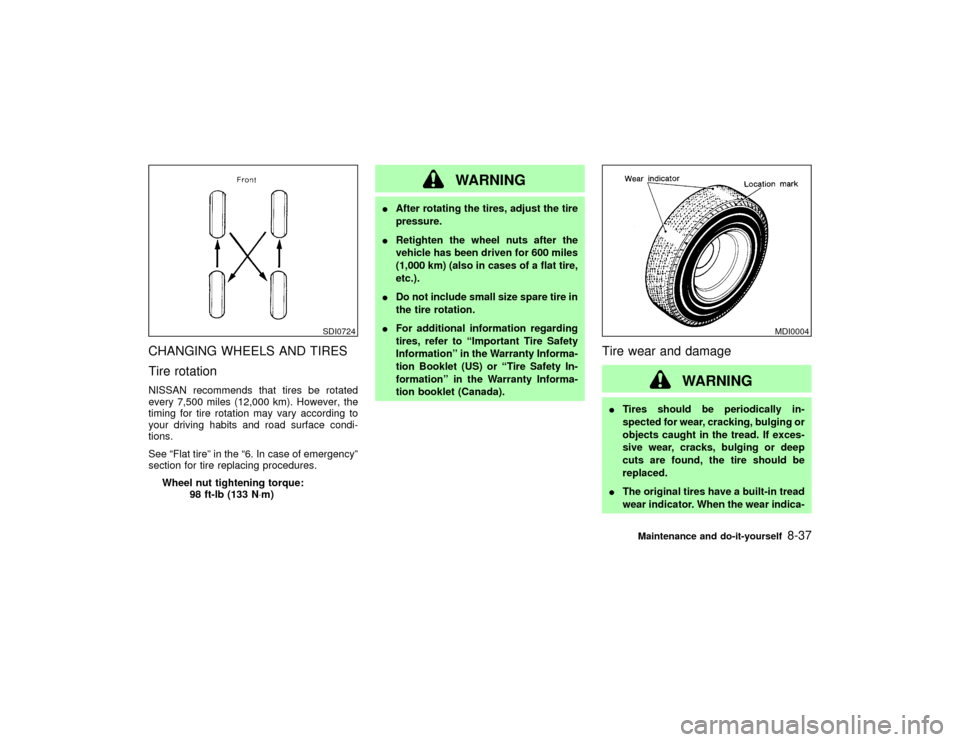
CHANGING WHEELS AND TIRES
Tire rotationNISSAN recommends that tires be rotated
every 7,500 miles (12,000 km). However, the
timing for tire rotation may vary according to
your driving habits and road surface condi-
tions.
See ªFlat tireº in the ª6. In case of emergencyº
section for tire replacing procedures.
Wheel nut tightening torque:
98 ft-lb (133 N×m)
WARNING
IAfter rotating the tires, adjust the tire
pressure.
IRetighten the wheel nuts after the
vehicle has been driven for 600 miles
(1,000 km) (also in cases of a flat tire,
etc.).
IDo not include small size spare tire in
the tire rotation.
IFor additional information regarding
tires, refer to ªImportant Tire Safety
Informationº in the Warranty Informa-
tion Booklet (US) or ªTire Safety In-
formationº in the Warranty Informa-
tion booklet (Canada).
Tire wear and damage
WARNING
ITires should be periodically in-
spected for wear, cracking, bulging or
objects caught in the tread. If exces-
sive wear, cracks, bulging or deep
cuts are found, the tire should be
replaced.
IThe original tires have a built-in tread
wear indicator. When the wear indica-
SDI0724
MDI0004
Maintenance and do-it-yourself
8-37
Z
01.9.21/R50-D/V5
X
Page 247 of 288
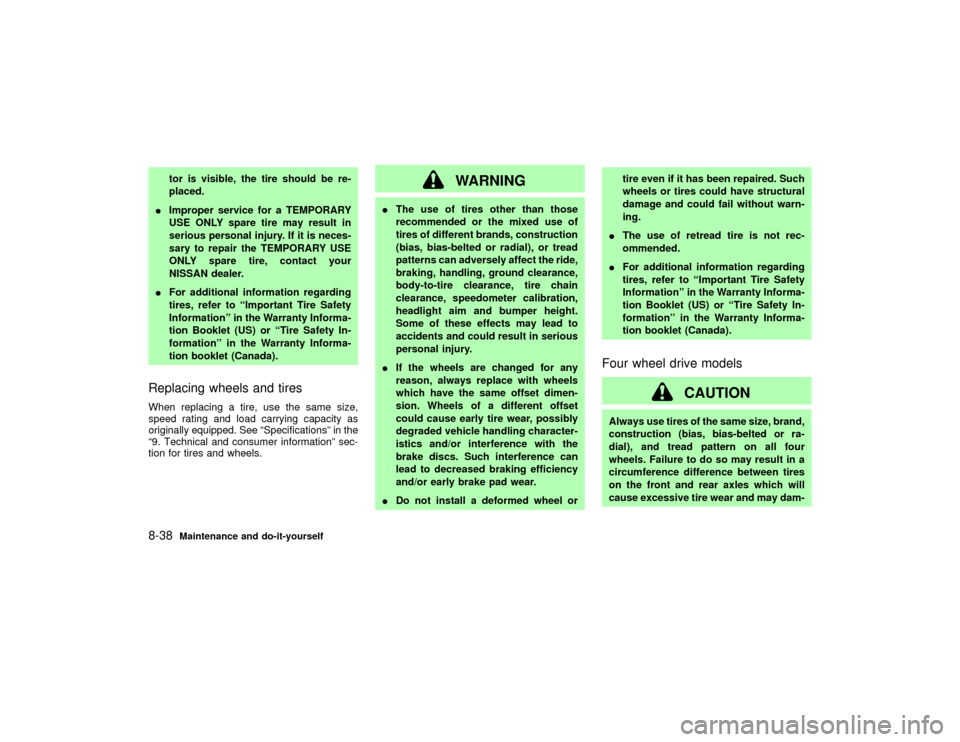
tor is visible, the tire should be re-
placed.
IImproper service for a TEMPORARY
USE ONLY spare tire may result in
serious personal injury. If it is neces-
sary to repair the TEMPORARY USE
ONLY spare tire, contact your
NISSAN dealer.
IFor additional information regarding
tires, refer to ªImportant Tire Safety
Informationº in the Warranty Informa-
tion Booklet (US) or ªTire Safety In-
formationº in the Warranty Informa-
tion booklet (Canada).
Replacing wheels and tiresWhen replacing a tire, use the same size,
speed rating and load carrying capacity as
originally equipped. See ªSpecificationsº in the
ª9. Technical and consumer informationº sec-
tion for tires and wheels.
WARNING
IThe use of tires other than those
recommended or the mixed use of
tires of different brands, construction
(bias, bias-belted or radial), or tread
patterns can adversely affect the ride,
braking, handling, ground clearance,
body-to-tire clearance, tire chain
clearance, speedometer calibration,
headlight aim and bumper height.
Some of these effects may lead to
accidents and could result in serious
personal injury.
IIf the wheels are changed for any
reason, always replace with wheels
which have the same offset dimen-
sion. Wheels of a different offset
could cause early tire wear, possibly
degraded vehicle handling character-
istics and/or interference with the
brake discs. Such interference can
lead to decreased braking efficiency
and/or early brake pad wear.
IDo not install a deformed wheel ortire even if it has been repaired. Such
wheels or tires could have structural
damage and could fail without warn-
ing.
IThe use of retread tire is not rec-
ommended.
IFor additional information regarding
tires, refer to ªImportant Tire Safety
Informationº in the Warranty Informa-
tion Booklet (US) or ªTire Safety In-
formationº in the Warranty Informa-
tion booklet (Canada).
Four wheel drive models
CAUTION
Always use tires of the same size, brand,
construction (bias, bias-belted or ra-
dial), and tread pattern on all four
wheels. Failure to do so may result in a
circumference difference between tires
on the front and rear axles which will
cause excessive tire wear and may dam-
8-38
Maintenance and do-it-yourself
Z
01.9.21/R50-D/V5
X
Page 248 of 288
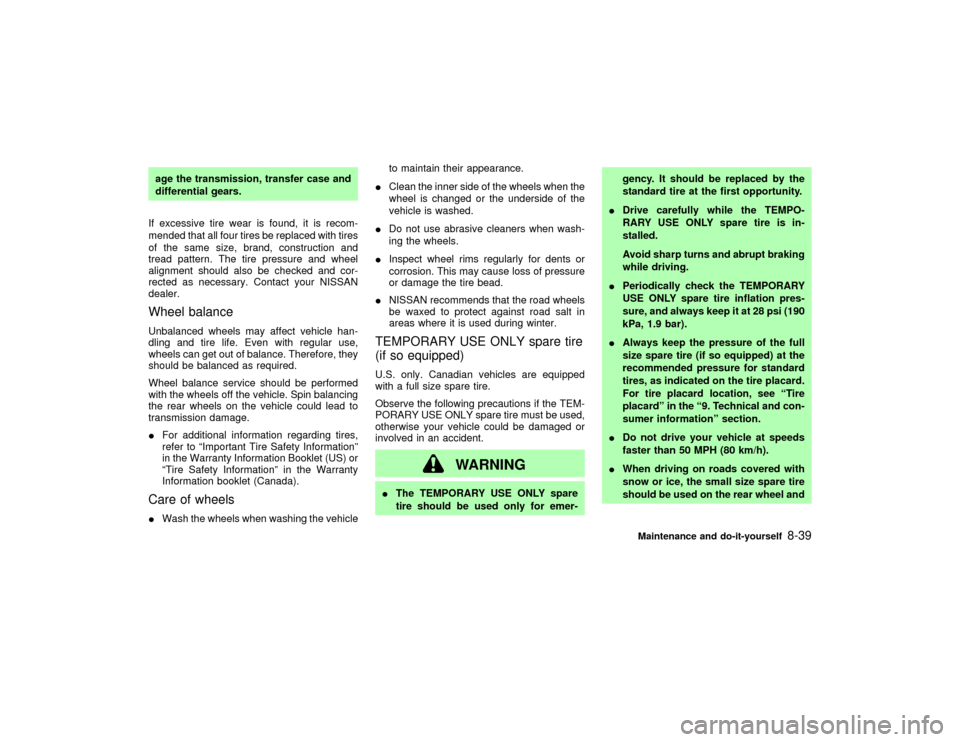
age the transmission, transfer case and
differential gears.
If excessive tire wear is found, it is recom-
mended that all four tires be replaced with tires
of the same size, brand, construction and
tread pattern. The tire pressure and wheel
alignment should also be checked and cor-
rected as necessary. Contact your NISSAN
dealer.Wheel balanceUnbalanced wheels may affect vehicle han-
dling and tire life. Even with regular use,
wheels can get out of balance. Therefore, they
should be balanced as required.
Wheel balance service should be performed
with the wheels off the vehicle. Spin balancing
the rear wheels on the vehicle could lead to
transmission damage.
IFor additional information regarding tires,
refer to ªImportant Tire Safety Informationº
in the Warranty Information Booklet (US) or
ªTire Safety Informationº in the Warranty
Information booklet (Canada).Care of wheelsIWash the wheels when washing the vehicleto maintain their appearance.
IClean the inner side of the wheels when the
wheel is changed or the underside of the
vehicle is washed.
IDo not use abrasive cleaners when wash-
ing the wheels.
IInspect wheel rims regularly for dents or
corrosion. This may cause loss of pressure
or damage the tire bead.
INISSAN recommends that the road wheels
be waxed to protect against road salt in
areas where it is used during winter.
TEMPORARY USE ONLY spare tire
(if so equipped)U.S. only. Canadian vehicles are equipped
with a full size spare tire.
Observe the following precautions if the TEM-
PORARY USE ONLY spare tire must be used,
otherwise your vehicle could be damaged or
involved in an accident.
WARNING
IThe TEMPORARY USE ONLY spare
tire should be used only for emer-gency. It should be replaced by the
standard tire at the first opportunity.
IDrive carefully while the TEMPO-
RARY USE ONLY spare tire is in-
stalled.
Avoid sharp turns and abrupt braking
while driving.
IPeriodically check the TEMPORARY
USE ONLY spare tire inflation pres-
sure, and always keep it at 28 psi (190
kPa, 1.9 bar).
IAlways keep the pressure of the full
size spare tire (if so equipped) at the
recommended pressure for standard
tires, as indicated on the tire placard.
For tire placard location, see ªTire
placardº in the ª9. Technical and con-
sumer informationº section.
IDo not drive your vehicle at speeds
faster than 50 MPH (80 km/h).
IWhen driving on roads covered with
snow or ice, the small size spare tire
should be used on the rear wheel and
Maintenance and do-it-yourself
8-39
Z
01.9.21/R50-D/V5
X
Page 249 of 288
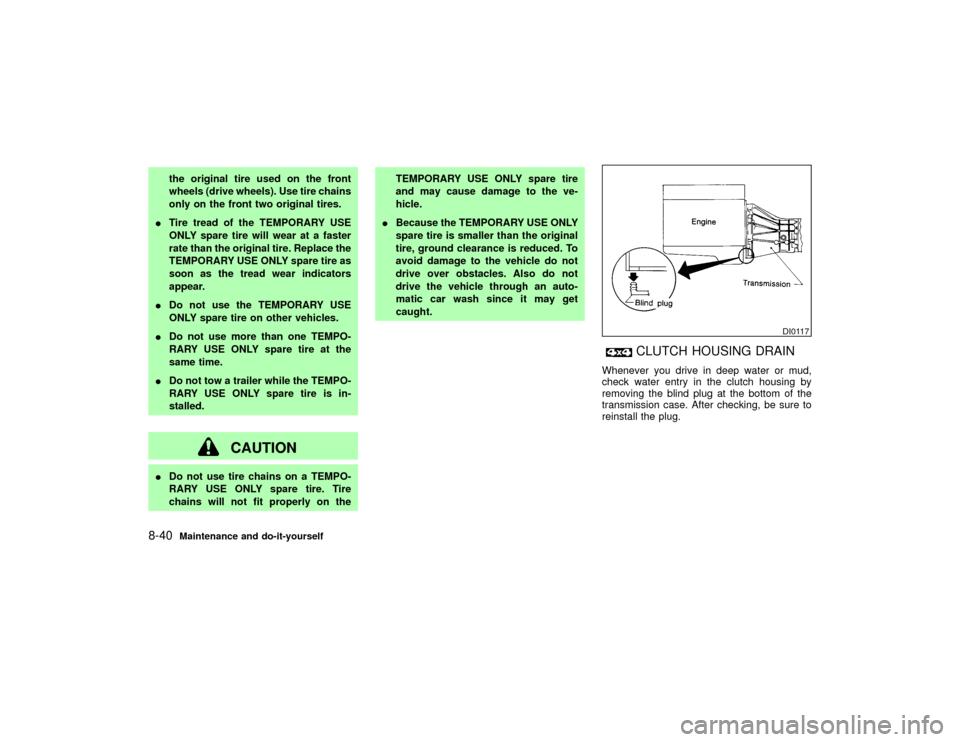
the original tire used on the front
wheels (drive wheels). Use tire chains
only on the front two original tires.
ITire tread of the TEMPORARY USE
ONLY spare tire will wear at a faster
rate than the original tire. Replace the
TEMPORARY USE ONLY spare tire as
soon as the tread wear indicators
appear.
IDo not use the TEMPORARY USE
ONLY spare tire on other vehicles.
IDo not use more than one TEMPO-
RARY USE ONLY spare tire at the
same time.
IDo not tow a trailer while the TEMPO-
RARY USE ONLY spare tire is in-
stalled.
CAUTION
IDo not use tire chains on a TEMPO-
RARY USE ONLY spare tire. Tire
chains will not fit properly on theTEMPORARY USE ONLY spare tire
and may cause damage to the ve-
hicle.
IBecause the TEMPORARY USE ONLY
spare tire is smaller than the original
tire, ground clearance is reduced. To
avoid damage to the vehicle do not
drive over obstacles. Also do not
drive the vehicle through an auto-
matic car wash since it may get
caught.
CLUTCH HOUSING DRAIN
Whenever you drive in deep water or mud,
check water entry in the clutch housing by
removing the blind plug at the bottom of the
transmission case. After checking, be sure to
reinstall the plug.
DI0117
8-40
Maintenance and do-it-yourself
Z
01.9.21/R50-D/V5
X
Page 252 of 288

9 Technical and consumer informationCapacities and recommended fuel/lubricants ........... 9-2
Fuel recommendation........................................... 9-4
Engine oil and oil filter recommendation .............. 9-6
Recommended SAE oil viscosity number ............ 9-7
Air conditioning system refrigerant and lubricant
recommendations ................................................. 9-8
Specifications ............................................................ 9-9
Engine .................................................................. 9-9
Wheels and tires ..................................................... 9-11
Dimensions and weights .................................... 9-11
When traveling or registering your vehicle in another
country..................................................................... 9-12
Vehicle identification ............................................... 9-12
Vehicle identification number (VIN) plate ........... 9-12
Vehicle identification number (Chassis
number) .............................................................. 9-12
Engine serial number ......................................... 9-13
F.M.V.S.S. certification label .............................. 9-13
Emission control information label ..................... 9-14
Tire placard ........................................................ 9-14Air conditioner specification label ....................... 9-14
Vehicle loading information ..................................... 9-15
Terms ................................................................. 9-15
Determining vehicle payload capacity ................ 9-15
Securing the load ............................................... 9-16
Loading tips ........................................................ 9-16
Payload weight capacity ..................................... 9-17
Measurement of weights .................................... 9-17
Towing a trailer ....................................................... 9-17
Maximum load limits ........................................... 9-17
Towing load/specification chart .......................... 9-19
Towing safety ..................................................... 9-19
Uniform tire quality grading ................................ 9-21
Emission control system warranty .......................... 9-22
Reporting safety defects (US only) ......................... 9-22
Readiness for inspection/maintenance (I/M) test
(US only) ................................................................. 9-23
Owner's Manual/Service Manual order
information............................................................... 9-25
In the event of a collision ................................... 9-25
Z
01.9.21/R50-D/V5
X
Page 262 of 288

Grade Road wheel/
offset in (mm)Tire Spare tire size
4x2 PATH-
FINDERXE 16x7JJ Aluminum/
1.97 (50)*1P245/70R16
106SP245/70R16 106S
215/80R16 103M*2
SE
WIDE16x7JJ Aluminum/
0.79 (20)P255/65R16
106SP255/65R16 106S
215/80R16 103M*2
LE
WIDE17x8JJ Aluminum/
0.79 (20)P245/65R17
105SP245/65R17 105S
215/80R16 103M*2
4x4 PATH-
FINDERXE 16x7JJ Aluminum/
1.97 (50)*1P245/70R16
106SP245/70R16 106S
SE
WIDE16x7JJ Aluminum/
0.79 (20)P255/65R16
106SP255/65R16 106S
LE
WIDE17x8JJ Aluminum/
0.79 (20)P245/65R17
105SP245/65R17 105S
*1: Option
*2: If so equipped (for US)
DIMENSIONS AND WEIGHTSPATHFINDER
Overall length*1 in (mm) 182.7 (4,640)
Overall width in (mm) 69.7 (1,770)
71.7 (1,820)*2
Overall height in (mm) 68.1 (1,730)
67.9 (1,725)*2
Front tread in (mm) 58.3 (1,480)
60.6 (1,540)*2
Rear tread in (mm) 58.5 (1,485)
60.8 (1,545)*2
Wheelbase in (mm) 106.3 (2,700)
Gross vehicle weight rating
lb (kg)See the ªF.M.V.S.S. certification
labelº on the driver's side lock
pillar.
Gross axle weight rating
Front lb (kg)
Rear lb (kg)
*1: On spare tire carrier equipped models, the spare tire carrier adds 9.45 in (240
mm) to the overall length.
*2: SE and LE wide models
WHEELS AND TIRES
Technical and consumer information
9-11
Z
01.9.21/R50-D/V5
X
Page 268 of 288
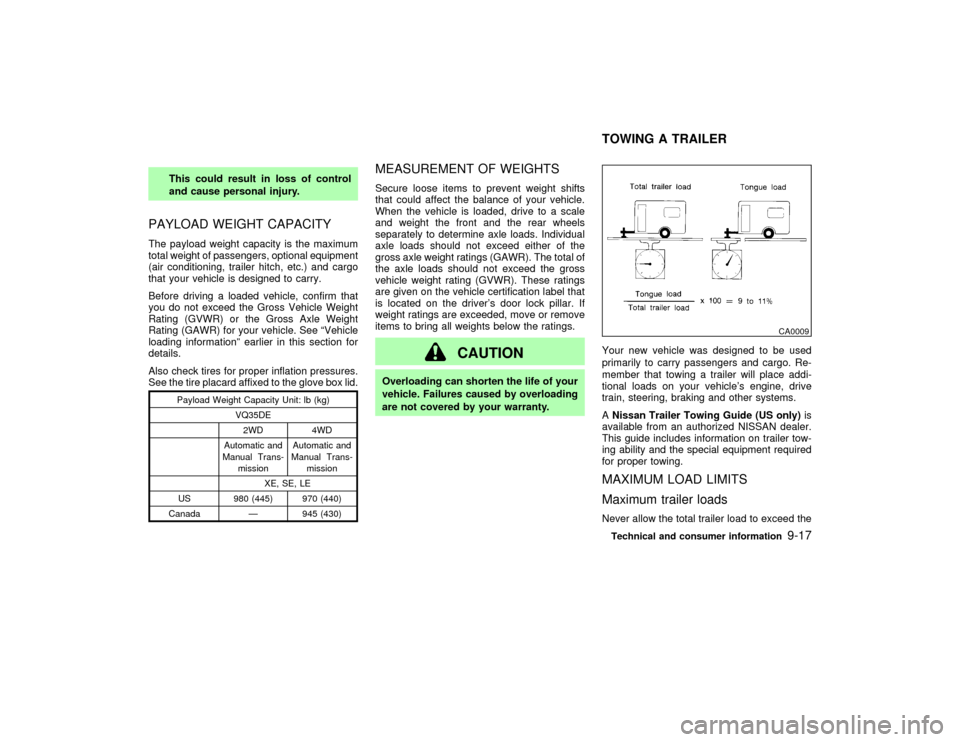
This could result in loss of control
and cause personal injury.
PAYLOAD WEIGHT CAPACITYThe payload weight capacity is the maximum
total weight of passengers, optional equipment
(air conditioning, trailer hitch, etc.) and cargo
that your vehicle is designed to carry.
Before driving a loaded vehicle, confirm that
you do not exceed the Gross Vehicle Weight
Rating (GVWR) or the Gross Axle Weight
Rating (GAWR) for your vehicle. See ªVehicle
loading informationº earlier in this section for
details.
Also check tires for proper inflation pressures.
See the tire placard affixed to the glove box lid.
Payload Weight Capacity Unit: lb (kg)
VQ35DE
2WD 4WD
Automatic and
Manual Trans-
missionAutomatic and
Manual Trans-
mission
XE, SE, LE
US 980 (445) 970 (440)
Canada Ð 945 (430)
MEASUREMENT OF WEIGHTSSecure loose items to prevent weight shifts
that could affect the balance of your vehicle.
When the vehicle is loaded, drive to a scale
and weight the front and the rear wheels
separately to determine axle loads. Individual
axle loads should not exceed either of the
gross axle weight ratings (GAWR). The total of
the axle loads should not exceed the gross
vehicle weight rating (GVWR). These ratings
are given on the vehicle certification label that
is located on the driver's door lock pillar. If
weight ratings are exceeded, move or remove
items to bring all weights below the ratings.
CAUTION
Overloading can shorten the life of your
vehicle. Failures caused by overloading
are not covered by your warranty.Your new vehicle was designed to be used
primarily to carry passengers and cargo. Re-
member that towing a trailer will place addi-
tional loads on your vehicle's engine, drive
train, steering, braking and other systems.
ANissan Trailer Towing Guide (US only)is
available from an authorized NISSAN dealer.
This guide includes information on trailer tow-
ing ability and the special equipment required
for proper towing.
MAXIMUM LOAD LIMITS
Maximum trailer loadsNever allow the total trailer load to exceed the
CA0009
TOWING A TRAILERTechnical and consumer information
9-17
Z
01.9.21/R50-D/V5
X